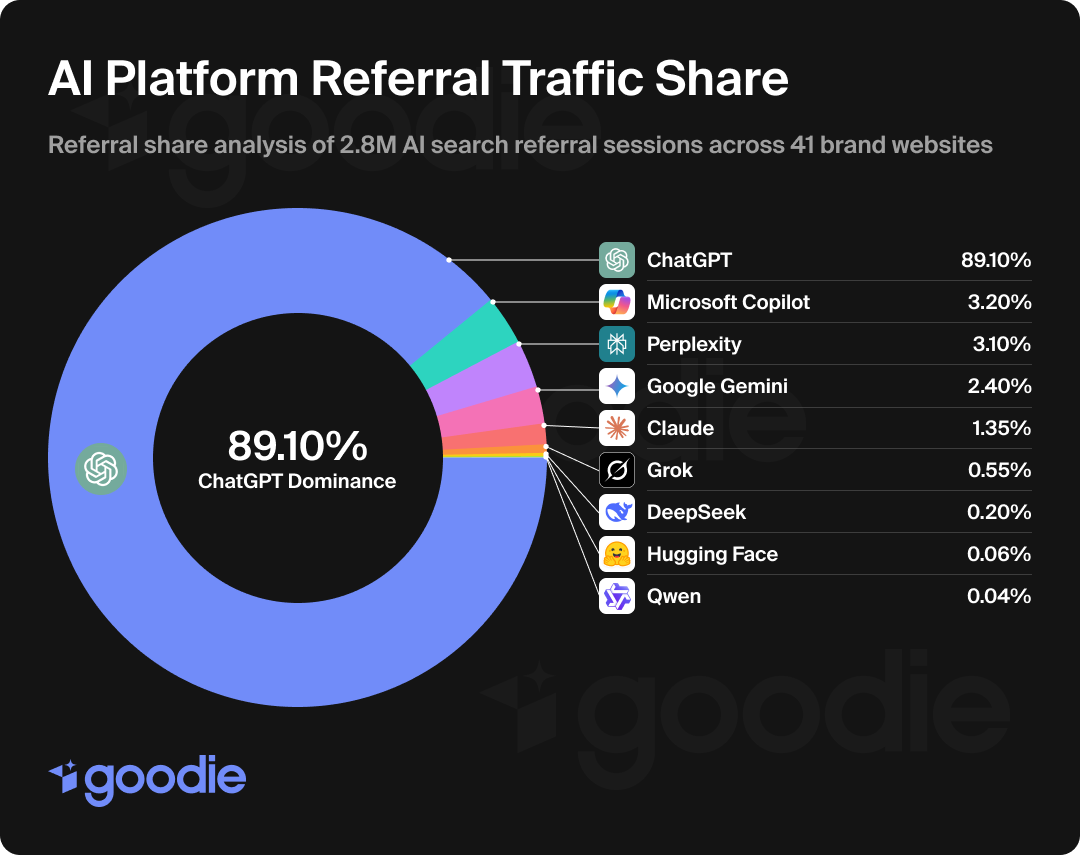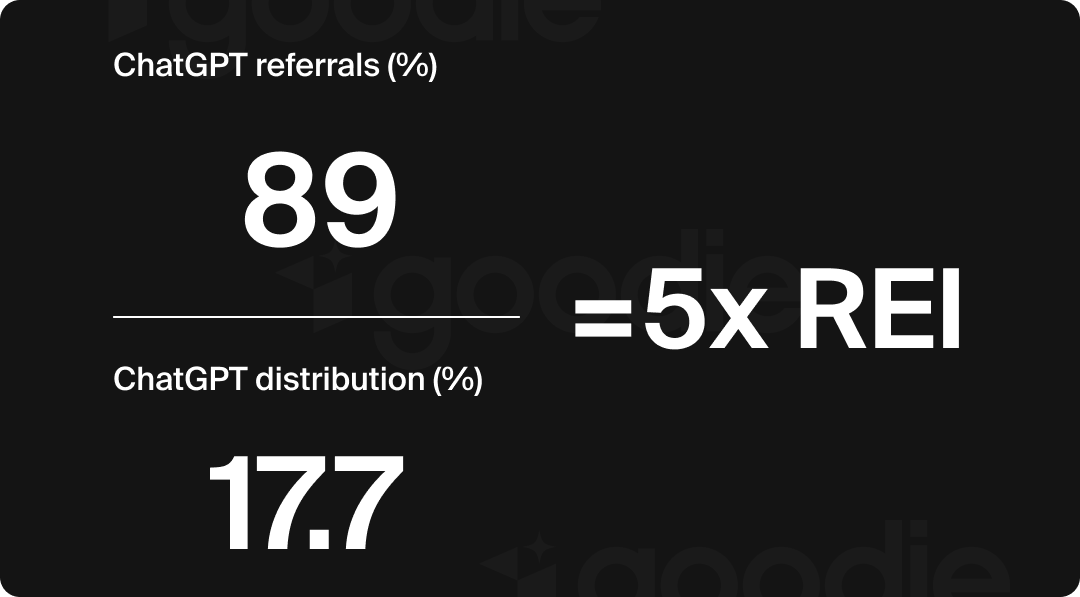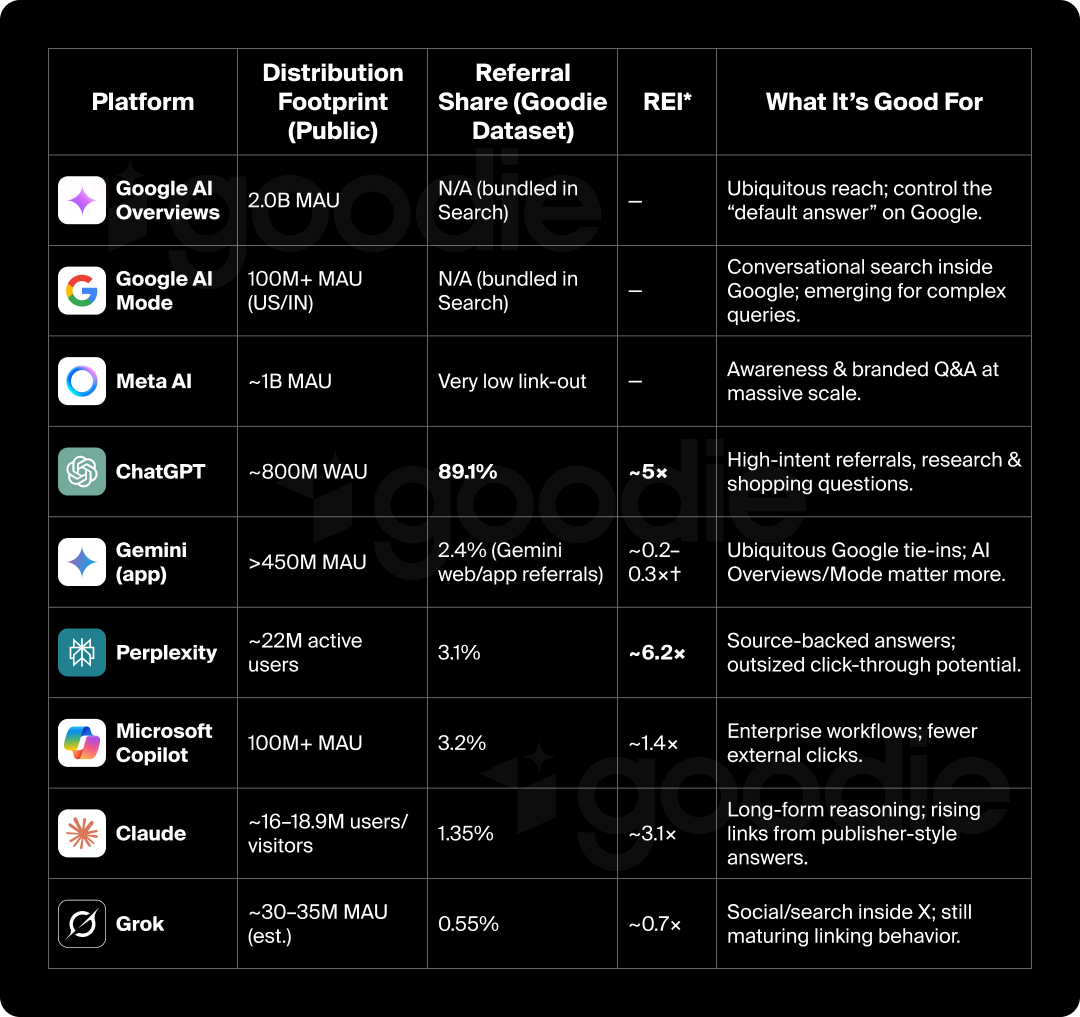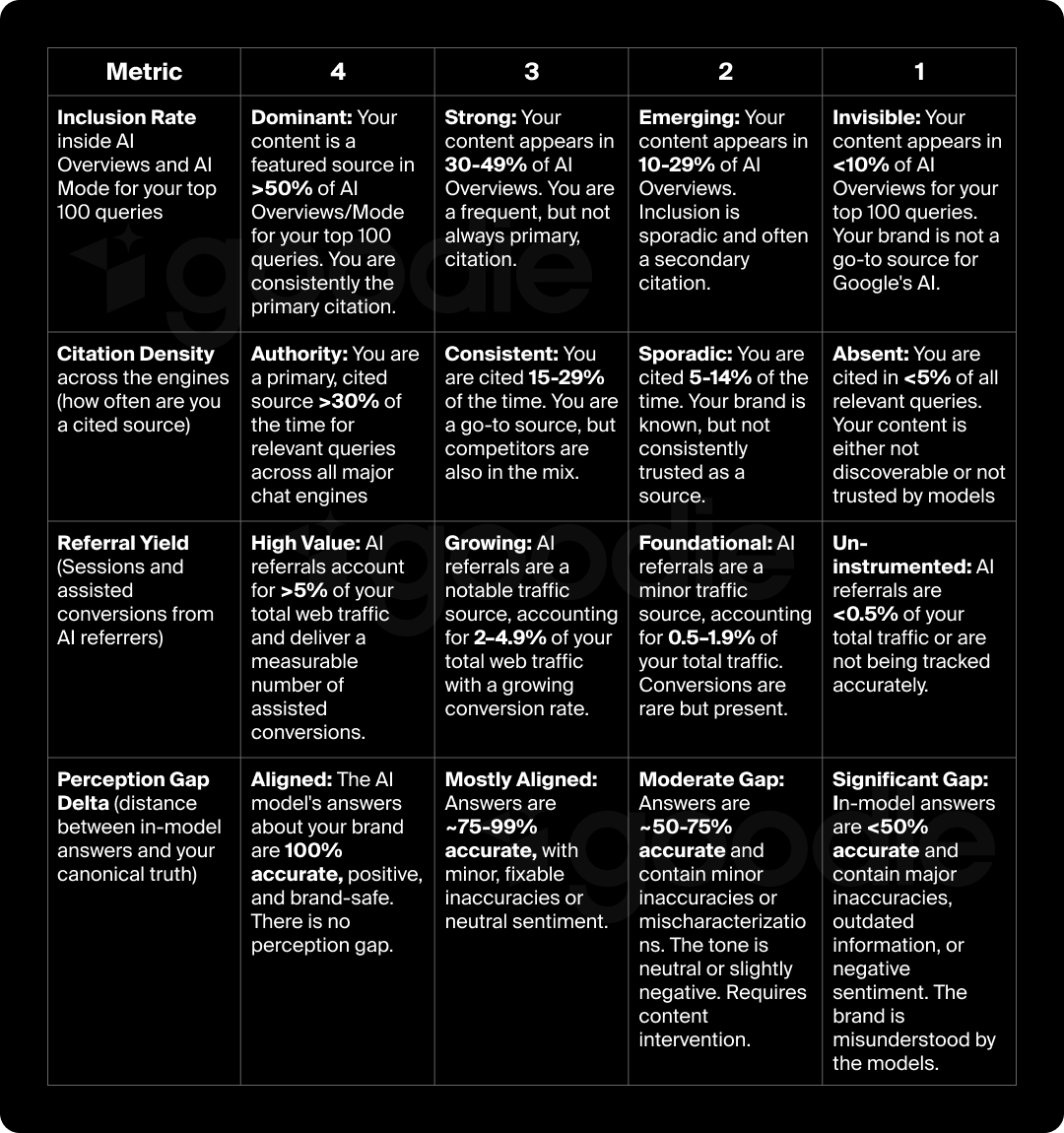

When ChatGPT became the fastest-growing consumer application in history, it was easy to glorify it as the “ultimate” AI search engine. With over 800 million monthly active users (MAU), that number alone seemed to tell the whole story; the more users, the better the chance you have at gaining visibility and traffic. Seems logical, right? But if you’ve been focused solely on that one metric, you're missing the bigger picture of what's happening in AI search.
The real story isn't just about active users; it's also about referrals. What are referrals? They’re the number of visitors who click a citation or link they discovered in an AI search platform and are sent to your site. This metric is a defining factor in the new organic search landscape as it tells you where people are coming from when they land on your site.
Here’s what may shock you: while chat-first engines like ChatGPT and Gemini are winning at referrals, platforms with built-in distribution (think Google AI Overviews and Meta AI) are winning users. Between February and October of 2025 alone, roughly 1 billion people actively used Meta AI, placing it second only to Google AI Overviews in terms of MAU, and capturing around 22.1% of the total AI search market share.
All of this data highlights our new reality. The battle for users versus the battle for referrals is defining the AI search world, and understanding the difference is critical for navigating organic search today. We're going to help you navigate it by giving you a clear read on this market using two complementary datasets:

Glorifying ChatGPT based on a one-dimensional view was a mistake. Why? Because it solely focused on users, not referrals; and surprise surprise, ChatGPT isn’t even the top player for users.
To truly understand AI search, you have to look at it through two distinct lenses: who is sending traffic to your site, and who has the users.
This refers to platforms that have a built-in, massive audience, measured here in monthly active users (MAU). These are often not chat-first engines but existing platforms that have integrated AI to enhance their core user experience.
The leaders here are Google, with its AI Overviews baked directly into the world's most popular search engine, and Meta, which has integrated AI into its billion-user-strong ecosystem of Facebook, Instagram, and WhatsApp. The goal of these platforms is often to answer a user's query directly and keep them within their ecosystem.
But user counts don’t tell the full story. When you shift to the referral lens, which tracks outbound clicks, the leaderboard flips.
This refers to platforms that are designed to cite external sources and drive users to your website. These are the chat-first engines whose business models are built around a more conversational, source-citing user journey.
Platforms like ChatGPT and Perplexity are dominant here, and their nature means they are far more likely to convert a user session into an outbound click.
But why does all of this matter? We’ll break it down for you:
Let's take a deeper look at the data.
The data reveals two distinct realities in AI search. Here, we’ll outline the numbers, first with Referral Share, which is the actual traffic sent to websites, and then by examining Distribution Baseline, the platforms with the largest user bases. By looking at these two metrics together, we can understand the full picture of which platforms are dominating and why.

Referral share tells us which AI platforms actually send users to brand websites. When an AI model cites your content, how often does that translate into a click? And which ones produce the most referrals?
From 2.8M sessions across 41 sites (May 1-Aug 31, 2025):
Important: This dataset excludes Google AI Overviews and AI Mode, because those appear inside Google Search and are not attributed as Referral sources in Google Analytics. Amazon Rufus is also excluded as it is part of a closed ecosystem.

Distribution tells us which AI platforms are winning the battle for user volume. Which platforms have the largest number of active users? And how does that reach then impact their overall market share?
Latest public figures show the real reach picture:
The data tells a story of two parallel realities. On one side, we have the user distribution; the sheer volume of people using platforms like Google AI Overviews and Meta AI. On the other hand, we have referral share, a metric that reveals which of these platforms is actually sending traffic to sites.
The first takeaway is a wake-up call for anyone focused on the traditional organic search model. The platforms with the biggest user base are not currently the ones driving the most referrals. This disconnect highlights a critical missed opportunity and presents a new challenge for marketers: you can be present in a billion-user ecosystem without receiving a single click.
Between its colossal AI Overviews (2 billion MAU) and the rapidly expanding AI Mode (100M+ MAU), Google’s AI surfaces dwarf every other chat engine in terms of raw user reach.
The catch? Google’s AI doesn’t show up in referral logs. Every AI Overview or AI Mode click is buried under “organic search” in GA4.
Think of classic SEO as the building blocks for visibility inside AI Overviews and AI Mode by prioritizing schema, trustworthy source coverage, and retailer and community signals, not only chat citations. You can do this through:
With almost 1 billion MAU across WhatsApp, Instagram, and Facebook, Meta AI has unparalleled ambient reach. It’s a tool that users engage with casually throughout their day. Today, linking out is limited, but the primary function of Meta AI is to provide instant answers and recommendations, which means it's a powerful layer for awareness, consideration, and branded answers.
Treat Meta AI like you would an early-stage distribution channel like Instagram Stories in 2018. The goal isn't last-click attribution, but brand seeding. Your strategy should focus on:
TL;DR: While Google and Meta AI have the most users they don’t show up in referral logs. This means marketers need a new strategy. To win Google's AI Overviews and AI Mode, you should optimize for SEO fundamentals like authoritative content, schema, and brand mentions. For Meta AI, which has a huge reach but limited linking, the focus should be on building brand awareness and creating "snackable" content that the model can easily use for instant answers. And remember that both platforms are designed to keep users within their ecosystem, not link them out.
Our dataset shows that 89% of measured AI referrals come from ChatGPT. This is a dramatic over-indexing relative to its ~17.7% share of the overall blended distribution baseline. What this really means is that ChatGPT sends far more clicks than its market share would suggest, because it’s designed to, unlike much of Google and Meta AI’s integrated features.
To help you understand the true value of this data, we’re gonna give you a new metric that breaks down these numbers even further. We call the comparison between these two datasets the Referral Efficiency Index (REI): referrals relative to distribution (referrals / active users). Based on this formula, ChatGPT’s REI is approximately 5x.

This phenomenal efficiency is a direct result of its design: it's a "chat-first" engine that is built to provide an answer and then, crucially, cite its sources with clear, clickable links.
You should optimize for ChatGPT when your priority is getting traffic, now. This requires a strategy focused on:
With a relatively small user base (~0.5% baseline share), Perplexity still drove a remarkable 3.1% of all referrals in our data. This gives it an REI of approximately 6.2x, the highest in our analysis (move over, ChatGPT).
In other words, a single Perplexity user is far more valuable for generating traffic than a user on other platforms.
Why? Its product is designed to cite and for users to click out. If your content is in a research-heavy, technical, or comparison-driven category, you can harvest real, high-quality traffic from Perplexity with:
Despite its integration into the Windows and Microsoft 365 ecosystems and a user base of over 100M MAU, Copilot delivered only 3.2% of our measured referrals (an REI of ~1.5x).
This low efficiency is intentional; Copilot's strength is task completion and in-app assistance inside Microsoft's surfaces, not pushing users outward to the open web.
If you sell to enterprise or developer audiences, your focus for Copilot should not be on traffic. Instead, it should be on ensuring your brand and product are:
While it might seem that Copilot is underperforming, you need to remember that this platform has a different purpose than others. It’s designed for users to complete tasks within the Microsoft ecosystem, not send them back out onto the web. So, for the purpose it was designed for, Copilot actually isn’t failing; it’s performing exactly as intended.
This chart provides a side-by-side comparison of the AI search landscape, moving beyond a single metric to reveal the full story.
On one side, we have Distribution Footprint, which shows the raw number of users each platform commands.
On the other hand, we have Referral Share, which measures the actual traffic each platform sends to websites. By analyzing these two metrics together, it’ll help us decipher what each platform is uniquely good for.

* REI (Referral Efficiency Index) = Referral share ÷ Blended baseline share (only where apples-to-apples was possible).
† The Gemini line mixes app MAU with web/app referrals; treat the ratio directionally.
In the past, you could look at a Google Analytics referral log and get a clear picture of where your traffic was coming from. That's no longer the case; AI has created a measurement chasm, making it more difficult than ever to attribute success accurately.
Here’s why your standard GA setup is undercounting your AI visibility and how you can fix it.
Google AI Overviews and AI Mode, despite having over 2.1 billion MAU combined, don't show up in your GA4 referral logs. They're a part of Google Search, so you’ll see outcomes as organic impressions and clicks, not as a separate referrer.
Traffic from chat-first platforms like ChatGPT, Perplexity, and Claude is often miscategorized under generic "referrals" or even "direct traffic.” To get a clear picture, you must explicitly configure your GA4 to track these sources.
Before AI can cite your content, its specialized web crawler must crawl and index it. These crawlers (like GPTBot or PerplexityBot) are a key indicator of public interest.
You might think a user’s journey from visibility to conversion with AI might look something like this: visibility → mentions → citations → referrals, but in fact, it’s a non-linear chain. Here’s why:
With the data deconstructed, it's time to translate insights into action. This playbook outlines the specific strategies you need to employ for each major AI platform to capitalize on its unique strengths, whether for user distribution, referrals, or both.
Your strategy here is inclusion first, clicks second. Google’s AI features are designed to keep users on the search results page. Your goal is to be the trusted source that an AI model relies on for its answer, even if the user never clicks your link.
Expect minimal link-out from Meta AI. With its unparalleled reach of nearly 1 billion users, this platform is a brand-building and mindshare channel, not a traffic driver.
This is your #1 near-term traffic driver. Our data shows that Perplexity is the most efficient platform for converting user sessions into outbound referrals, with an REI of ~6.3x.
Treat ChatGPT like a turbocharged research engine. Its users are in research mode and are highly motivated to click out for a deeper dive. Its REI of ~5x proves that it punches far above its weight.
Copilot is less about driving external traffic and more about productivity and enterprise workflows. Its primary value is in task completion inside the Microsoft ecosystem.
Claude is known for its long-form reasoning and empathetic tone, making it a valuable tool for customer service and complex problem-solving with a respectable REI of ~3.2x.
The most dangerous assumption a marketer can make in 2025 is that AI search is a single, unified channel. It's not. It encompasses two distinct problems that require a dual-pronged strategy: reach (Google, Meta) and referrals (ChatGPT, Perplexity, Claude).
As you plan your budget for 2025, a methodical split is highly recommended to reflect these two distinct problems:
You can't manage what you don't measure. You may not like it, but you need to abandon outdated KPIs and adopt a modern framework that reflects the nature of AI search. We’ve created a rubric to help you figure out your brand’s current standing that should help you identify potential opportunities and build a data-driven strategy.
Perception Gap Delta (Brand Health): This is a critical metric for a brand-safe era. It measures the distance between how AI models talk about your brand and your canonical truth. Are models sharing accurate information? Is the sentiment positive, neutral, or negative? You must monitor this in Goodie to protect your brand in real-time.

Distribution ≠ referrals. Google and Meta already command the audience. ChatGPT (and Perplexity) command the clicks and users’ mindshare.
Winning AI search in 2025 means having a strategy that acknowledges both of these realities. You must simultaneously:
This isn't about choosing one path over another; It's about recognizing that the AI landscape has split into two separate, but equally critical, challenges. Your success will be measured by how effectively you can master both being the answer and driving the click.


